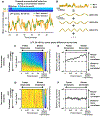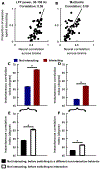Correlated Neural Activity across the Brains of Socially Interacting Bats
- PMID: 31230710
- PMCID: PMC6625887
- DOI: 10.1016/j.cell.2019.05.023
Correlated Neural Activity across the Brains of Socially Interacting Bats
Abstract
Social interactions occur between multiple individuals, but what is the detailed relationship between the neural dynamics across their brains? To address this question across timescales and levels of neural activity, we used wireless electrophysiology to simultaneously record from pairs of bats engaged in a wide range of natural social interactions. We found that neural activity was remarkably correlated between their brains over timescales from seconds to hours. The correlation depended on a shared social environment and was most prominent in high frequency local field potentials (>30 Hz), followed by local spiking activity. Furthermore, the degree of neural correlation covaried with the extent of social interactions, and an increase in correlation preceded their initiation. These results show that inter-brain correlation is an inherent feature of natural social interactions, reveal the domain of neural activity where it is most prominent, and provide a foundation for studying its functional role in social behaviors.
Keywords: LFP; bats; correlation; electrophysiology; frontal cortex; hyperscanning; mammal; multiunit; single unit; social behavior.
Copyright © 2019 Elsevier Inc. All rights reserved.
Conflict of interest statement
Declaration of Interests
The authors declare no competing interests.
Figures







Comment in
-
Social Minds Sync Alike.Cell. 2019 Jul 11;178(2):272-274. doi: 10.1016/j.cell.2019.06.019. Cell. 2019. PMID: 31299199
References
-
- Adolphs R (2001). The neurobiology of social cognition. Curr. Opin. Neurobiol 11, 231–239. - PubMed
-
- Amodio DM, and Frith CD (2006). Meeting of minds: the medial frontal cortex and social cognition. Nat. Rev. Neurosci 7, 268–277. - PubMed
-
- Anderson DJ (2016). Circuit modules linking internal states and social behaviour in flies and mice. Nat. Rev. Neurosci 17, 692–704. - PubMed
-
- Anderson DJ, and Perona P (2014). Toward a science of computational ethology. Neuron 84, 18–31. - PubMed

